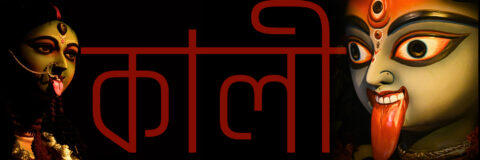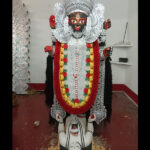There are moments in mythology where divinity frightens us before it frees us. Kali is that moment—raw, untamed, and infinite. She is not the gentle mother you paint on temple walls; she is the puja’s midnight fire, the silence that follows destruction, and the timeless whisper that says, “To become whole, you must first burn away the false.” Born from the wrath of Durga in the Devi Mahatmya, Kali emerged in a battlefield drenched in the blood of arrogance and ignorance. The tale speaks of the demon Raktabija, whose every drop of blood created more of himself. None could stop him—until Durga’s anger became form, fury, and freedom. From her brow leapt the dark goddess, black as void, aglow with cosmic fire. She drank the demon’s blood before it could touch the earth, ending his endless cycle. Yet, her victory was not peace—it was transformation. Her dance shook the worlds: fierce, unrestrained, an echo of time itself. And when her rage threatened to dissolve creation, Shiva lay at her feet—not to subdue her, but to remind her of love’s power amid chaos. In that instant, the wild mother became consciousness itself—terrifying and tender, the destroyer and the redeemer. Kali is not merely the goddess of death or destruction; she is the inevitable truth of endings that usher beginnings. She wears a garland of heads—symbols of ego, greed, and fear—and yet, beneath her wild laughter beats the heart of every mother who births, protects, and releases. Her blackness absorbs all color, her silence devours all noise. Her symbolism is not gruesome—it’s sacred. She holds the mirror that shows what we have to shed before we can evolve. To worship Kali is not to fear her; it is to surrender to honesty. She teaches that purity is not polished—it is born from breaking, from facing the self you hide. Each of us carries a fragment of Kali—the courage to confront darkness, the compassion to outlast pain, the laugh that rises after grief.As nights lengthen and the drumbeat of devotion echoes through Bengal’s lanes, Kali reminds us: creation and destruction are not opposites—they are the same breath. Her dance is not of ending but renewal.
In embracing her, we embrace our shadows, and in her fierce eyes, we find our own awakening.
The lanes of Bengal have always hummed with a kind of madness — not the chaos of markets or politics, but the wild, trembling madness of faith. It takes the shape of a black goddess: Kali, fierce and tender, standing naked in the dark, her tongue dripping red, her eyes blazing with the knowledge of creation and destruction. Around her, in cremation grounds and hidden ashrams, under banyan trees and beside temple lamps that never go out, move her seekers — Kali sadhaks. These are not the polished monks of monasteries. They are barefoot, unpredictable, sometimes feared, sometimes revered. But through their devotion, they have ignited a spiritual spark that turned Bengal into a land where the divine wears the mask of the terrifying.
The Fire and the Ash
To understand a Kali sadhak, one must abandon the idea of religion as something polite.
Kali sadhana — the spiritual pursuit of Goddess Kali — is not about asking for blessings; it is about embracing annihilation. The sadhak seeks liberation not through denial of the world, but through confronting its rawest essence — death, desire, time, and the untamable self. In Bengal, this path was shaped by cremation-ground mystics known as Aghoris and Kapaliks, by Tantric masters who chanted mantras through nights of thunder and storm. Their practices were meant to shatter illusion — maya — and face the truth of impermanence head-on. When others saw the burning ghats as an end, the Kali sadhak saw them as doorways.
Krishnananda Agamavagisha:
A Tantric scholar from Nabadwip, Bengal, wrote the Tantrasara and is famous for putting Kali worship into a system that people could easily follow.
What makes him a Kali worshiper?
- He made Kali worship (specifically Dakshina Kali) popular in Bengal, and he didn’t keep it secret.
- As a Tantric person, he probably did more than sing devotional songs. He likely did meditations, rituals, and faced death or his ego, like most people in the Kali tradition (Kalikula) instead of the more family-friendly one (Shrikula).
Why is his way of worship cool?
- He shows how Kali worship is built. He provides texts, ritual instructions, and explanations for things that used to be secret.
- His life suggests that crazy devotional poets such as Ramprasad or Kamalakanta stood strong because of people like Krishnananda.
- He reminds us that Kali worship in Bengal has deep Tantric origins. It’s not just songs and puja, but transformation, ego breakdown, and acceptance around the idea of death.
A few thoughts and links:
- These worshipers (one very old, one from today) show different kinds of Kali devotion: well structured (Krishnananda) and wild (Bhaba Pagla).
- In Bengal, Kali devotion changes form: from cremation-ground practices (like at Tarapith) to songs, to organized temples and texts.
- It’s good to see Kali practice as a mind and soul change, in which your ego breaks, in which a person faces death, giving themself up, instead of just worshiping a goddess. The worshiper turns into a mirror of the divine.
- The craziness or weird behavior you see in Kali followers isn’t always a problem. It can be a stand-in for the end of who they think they are.
Krishnananda, a tantric scholar from Nabadwip, Bengal, is famous for writing Tantrasara and organizing Kali worship. (Info from Wikipedia)
What makes him a Kali devotee?
- He helped make Kali worship (specifically Dakshina Kali) popular in Bengal, opening it up to more people.
- As someone who practiced tantra, he probably did more than just sing devotional songs. He likely meditated, performed rituals, and faced death/ego, common in the Kali tradition (Kalikula), unlike the Shrikula tradition, which is friendlier to families.
Why is he interesting?
- He shows the structure behind Kali worship: the texts, rituals, and explanations of what was once secret.
- His life shows that crazy devotional poets like Ramprasad or Kamalakanta were inspired by people like Krishnananda who organized things.
- He reminds us that Kali worship in Bengal has deep tantric roots—more than just songs and prayer, but change, ego loss, and facing the idea of death
Some thoughts and connections:
- These devotees (one from a long time ago, one recent) show different versions of Kali devotion: structured (Krishnananda) and wild/folk (Bhaba Pagla).
- In Bengal, Kali devotion takes many forms: from tantra in cremation grounds (like Tarapith) to songs and dances, to temples and texts.
- It’s useful to see Kali worship not just as worship of a goddess but as changing your mind and spirit: shattering the ego, confronting death, and giving up the self. The devotee is not just a worshiper but a reflection of the divine.
- The madness or strange behavior often seen in Kali devotees isn’t necessarily a problem. It’s a way to show the loss of normal identity.
Ramprasad and Kamalakanta: The Bright Darkness
Two names shine: Ramprasad Sen and Kamalakanta Bhattacharya. Both were poets, both loved Kali deeply, and both found her in personal relationship, not just ritual. Ramprasad called her Ma (Mother), who dances on his chest, scolding, loving, and teasing him. His songs (Ramprasadi Padabali) turned Kali from a scary goddess into a close friend. He made the terrifying goddess tender. He helped Bengal find devotion in tantra—love in the dark. Kamalakanta, more unusual, spoke to her like a drunk lover, making fun of his own ego until it disappeared into laughter and longing. He was known to wander Kolkata’s streets, mumbling prayers that sounded like poems and jokes. Together, they made it okay to love the dark.
Ramakrishna Paramhansa: The Joyful Revolution
A century later came Ramakrishna, a priest at the Dakshineswar Kali Temple. He wasn’t a scholar but a visionary, not a preacher but a man taken over. His relationship with Kali was super personal, like a child with his mom. He saw her everywhere: in stones, trees, and strangers’ eyes. His joyful trances scared some but inspired many. He broke rules, worshiped Allah, Christ, and Radha-Krishna, and said they were all faces of Kali, the mother consciousness. He took Kali from the cremation ground to the world. His student, Swami Vivekananda, spread her message that spiritual awakening can go with clear thinking and helping others. Ramakrishna’s Kali wasn’t just in Bengal’s temples. She became the cosmic mother, embracing everyone.
The Hidden Sadhaks: Modern Mystics and Quiet Passion
Even now, Bengal keeps its mystics secret. In the villages of Birbhum, the forests of Bankura, and the ghats of Tarapith, sadhaks still chant her name. Tarapith, for Maa Tara (a fierce form of Kali), still feels like the line between life and death is thin. There, you can find babas who put ash on themselves, meditate on dead bodies, and see the eternal dance of Shakti, not just horror. These aren’t famous people. They live simply, speak little, and have silent wisdom. They say a true Kali devotee learns to die before death—to lose their ego completely so only the divine remains. They even find destruction beautiful because it shows truth without lies.
The Land Where the Goddess Never Sleeps
Tarapith in Birbhum, West Bengal, seems normal during the day with shops and red flowers. But when night comes, it changes. Drums echo from Maa Tara’s temple, lamps flicker, and smoke rises from the cremation ground like a prayer. This is where Bama Charan Chattopadhyay (Bamakhyapa, the mad one blessed by Mother Tara) lived, worshiped, and questioned everything.
The Boy Who Couldn’t Be Controlled
Bamakhyapa was born in a village near Tarapith in the mid-1800s. He was restless, drawn to the forest and the sadhus’ songs. He’d wander, saying the goddess’s name. His family thought he was crazy, but he was just passionately devoted. He studied with Kailashpati Baba, a tantrik, who saw his potential and led him to the scary rituals of the cremation ground where death and divinity mix.
The Mad Tara Devotee
People called him Khapā (the mad one), but his madness was bright. He saw Maa Tara as a living mother who talked to him, not just an idol. He sometimes yelled at her, sometimes laughed with her like a child. He offered her alcohol and meat to honor life as it is, the Tantric way. Once, priests wouldn’t let him into the temple because he was impure. He cried out to the goddess, and the temple doors opened by themselves. The priests dreamed of Tara next to Bama, smiling. He said, You call her Devi. I call her Ma. She can’t stay away from her child. That was his raw, direct belief.
1. Ramprasad Sen (1723–1775): The Poet Who Loved Kali
Ramprasad made Kali personal. Before him, she was the scary mother of destruction. After him, she was Ma, the playful mother who scolds and forgives. Ramprasad wrote like a child in love, not a priest. His songs (Ramprasadi Padabali) are still sung everywhere in Bengal. He saw both devotion and despair, faith and doubt. He once asked Kali: If I die crying for you, Mother, will you come to wipe my tears? That question still resonates. He turned devotion and spiritual practice into one. Ramprasad’s Kali is not just the goddess of death but the Mother of Everything, whose darkness hides light.
2. Kamalakanta Bhattacharya (1769–1821): The Mad Bhakti-Tantra Poet
Kamalakanta sang with laughter, while Ramprasad sang with tears. He wandered Calcutta’s streets, a bit drunk, a bit divine, muttering poems that mixed devotion, philosophy, and humor. His Kali is wild, both scary and beautiful. He mocks her, loves her, argues with her, and gives in to her. He once wrote: Mother, if you’re so compassionate, why do you make me long so much? He lived a normal life, but his inner life was tantric. He showed that you can be spiritual in the chaos of life—amid laughter, hunger, and heartbreak.
3. Ramakrishna Paramhansa (1836–1886)
Ramakrishna lit up modern Bengal’s spiritual world. He was born in Kamarpukur and later became a priest at the Dakshineswar Kali Temple. He turned Kali worship into a joyful expression of universal love. To him, the goddess was real. He went into trances, cried like a child, and said she was the mother of all paths, the truth behind every religion. He saw Christ and Krishna in her. He saw Kali not as evil but as power and taught to see her in everything—joy, pain, and death. His student Swami Vivekananda spread his vision of Kali worldwide. She became a symbol of truth beyond fear.
4. Bamakhyapa (1837–1911)
You met him earlier, the barefoot mystic who howled at the goddess in Tarapith’s cremation ground. His name means Bama the Mad, and his madness was divine intoxication. Unlike Ramakrishna’s calm mysticism, Bama’s path was wild, rooted in the cremation ground. He saw no difference between purity and filth, holiness and madness. To him, the goddess was both the destroyer and the nurturer. When people mocked him, he laughed. He represented Kali’s paradox: terrible and tender, insane and wise.
6. Sri Sadhananda Brahmachari (1877–1925): The Avadhuta of Kalighat
Known as Sadhan Baba, he lived near Kalighat Temple in Kolkata, a powerful Kali shrine. He gave up comfort early, spending decades in silence. People said he could go without food or speech, absorbed in the Mother. Unlike the tantrics of Tarapith, Sadhan Baba’s practice was internal. He believed that worshiping Kali through compassion was as holy as rituals. When someone hungry came, he’d feed them and say, That too is puja.
The Spark in the Ashes
The flame of Kali sadhaks has never gone out. It changes. Sometimes it’s poetry, sometimes rebellion, sometimes quiet devotion. Kali is the pulse within, the scream beneath silence, the storm that breaks illusion. And the sadhak is anyone brave enough to face her. To see Kali is to see truth. And that, once seen, lasts forever. The story of the Kali sadhaks of Bengal is a living heart. A wild beat that won’t stop. It’s the spark in everyone who whispers, Ma, take everything—just keep me near You.



